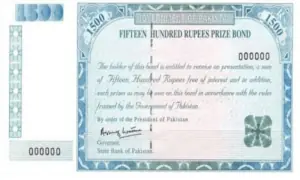Fitch Ratings upgrades Pakistan’s IDR to “B-”
Fitch Ratings has upgraded Pakistan’s Long-Term Foreign-Currency Issuer Default Rating (IDR) to “B-” from “CCC+”, citing fiscal consolidation and external stabilization as key factors.
The rating agency has also assigned a stable outlook to the rating.
Fitch’s upgrade reflects increased confidence in Pakistan’s ability to maintain recent progress in narrowing budget deficits and implementing essential structural reforms.
“This progress is deemed crucial for supporting the country’s performance under its International Monetary Fund (IMF) program and ensuring funding availability,” it said.
“We also expect tight economic policy settings to continue to support recovery of international reserves and contain external funding needs, although implementation risks remain and financing needs are still large.”
“Pakistan has demonstrated strong performance in meeting quantitative performance criteria, particularly in reserve accumulation and achieving a primary surplus. However, tax revenue growth has not met its indicative target.”
Additionally, Fitch stated that provincial governments have enacted legislation to increase agricultural income tax, marking a significant structural benchmark. This follows Pakistan’s commendable performance under its previous, more temporary arrangement, which concluded in April 2024.
Fitch forecasted that the general government budget deficit will decrease to 6% of GDP in the fiscal year ending June 2025 (fiscal year 2025) and around 5% in the medium term, down from nearly 7% in fiscal year 2024.
“The fiscal year 2025 forecast is considered conservative. The agency expected the primary surplus to more than double to over 2% of GDP in fiscal year 2025. Shortfalls in tax revenue, partly attributed to lower-than-expected inflation and imports, will be mitigated by reduced spending and increased provincial surpluses.”
Fitch Ratings reported that Pakistan recorded a current account (CA) surplus of $700 million in the first eight months of fiscal year 2025, driven by rising remittances and favorable import prices.
The agency noted that imports increased in early 2025, leading to expectations of widening external deficits, contrasting with a previously forecasted broadly balanced position for fiscal year 2025 due to stronger domestic demand. Nonetheless, these deficits are projected to remain below 1% of GDP in the coming years.
Fitch suggested that some informal foreign exchange demand management continues to exist following the relaxation of exchange rates and import controls, as well as market reforms implemented in 2023.
The agency cautioned that international trade tensions could negatively impact Pakistan’s goods exports, particularly textiles, which accounted for 3% of GDP (35% of total exports) in fiscal year 2024. However, lower commodity import prices might alleviate some pressure on the trade balance.
“Remittances, which are Pakistan’s primary source of external receipts, largely originate from the Middle East and tend to remain stable despite economic fluctuations. While Pakistan has reduced its reliance on market and commercial financing in recent years, the potential for market turmoil could still hinder access to loan funding.”
Fitch anticipated a further increase in gross reserves following the State Bank of Pakistan’s (SBP) purchases of foreign exchange in the interbank market, which raised reserves to just under $18 billion in March 2025, equivalent to about three months of external payments. This figure is up from approximately $15 billion at the end of fiscal year 2024 and a low of less than $8 billion in early 2023.
The agency indicated that measures of net foreign exchange reserves are significantly lower, due to deposits held by domestic commercial banks, a swap line with the Chinese central bank, and bilateral deposits at the SBP. Nevertheless, Fitch continues to regard gross reserves as the most relevant indicator of Pakistan’s external liquidity.
“The government [Pakistan] faces approximately $9 billion in external debt maturities in fiscal year 2026, following over $8 billion in fiscal year 2025 (nearly $5 billion in the second half of fiscal year 2025). Both amounts exclude $13 billion in bilateral deposits and loans that are routinely rolled over, of which $4 billion is at the SBP. The next international bond maturity is set for September 2025.”
In addition to bilateral rollovers, authorities secured $4 billion in external financing in the first half of fiscal year 2025 from a mix of multilateral and commercial sources, with expectations to secure an additional $10 billion in the second half of fiscal year 2025. This latter amount is anticipated to include $4 billion from multilateral sources and $5 billion from various commercial loans, primarily refinancing from Chinese banks.
Fitch noted that Prime Minister Shehbaz Sharif’s Pakistan Muslim League-Nawaz (PMLN) party and its allies received a weaker-than-expected mandate in the early 2024 elections; however, they still hold a constitutional majority in the National Assembly and have the backing of the influential military.
Also, it stated that former Prime Minister Imran Khan, who has been imprisoned since May 2023, remains highly popular among the public. Domestic political and economic divisions are exacerbated by an increase in security incidents along the border with Afghanistan and in Balochistan province.
Read more
Fitch upgrades Pakistan’s credit rating to CCC+ after IMF deal
Moody’s upgrades Pakistan’s credit ratings from Caa3 to Caa2
Securing sufficient external financing remains challenge for Pakistan: Fitch
The agency observed that governments across Pakistan’s political spectrum have had a mixed record concerning IMF program performance, often failing to implement or reversing necessary reforms. It warned that the current consensus on the need for reform could diminish over time, citing significant technical challenges ahead.
Fitch assigned Pakistan an Environmental, Social, and Governance (ESG) Relevance Score of ‘5’ for both political stability and rights, as well as for the rule of law, institutional and regulatory quality, and control of corruption, consistent with all sovereigns.
This scoring reflected the substantial weight that the World Bank Governance Indicators (WBGI) hold in Fitch’s proprietary Sovereign Rating Model (SRM). Pakistan ranks at the 22nd percentile in the WBGI, according to the rating agency.
For the latest news, follow us on Twitter @Aaj_Urdu. We are also on Facebook, Instagram and YouTube.




















Comments are closed on this story.